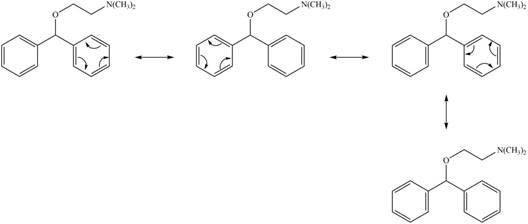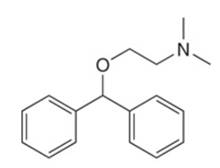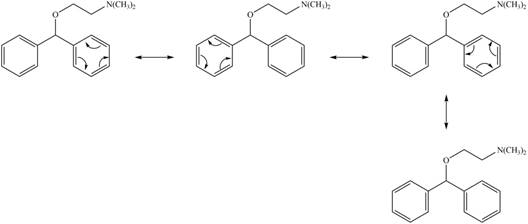
Concept explainers
Interpretation: All possible resonance structures for the antihistamine diphenhydramine are to be drawn.
Concept introduction: Resonance structure is a blend of two or more Lewis structures. Resonance structures are represented by a double headed arrow between the structures.
Answer to Problem 17.1P
All possible resonance structures for the antihistamine diphenhydramine are,

Explanation of Solution
The given structure of antihistamine diphenhydramine is shown below.

Figure 1
The given structure contains oxygen and nitrogen atoms and these atoms are not conjugated with any double bond. Thus, the lone pairs of these atoms do not participate in the resonance. Hence, possible resonance structures for the antihistamine diphenhydramine are shown below.

Figure 2
All possible resonance structures for the antihistamine diphenhydramine are shown in Figure 2.
Want to see more full solutions like this?
Chapter 17 Solutions
Organic Chemistry
- The structure of a potent analgesic agent (pain reliever) is provided below. Circle and identify each functional group in this compoundarrow_forward16. Draw significant resonance structures for the following compound. Which of this is/are most significant resonance structure(s)? Explain why. (a) مهم (b) the H H- (c)arrow_forwardWHY IS DIETHYLAMINE MORE BASIC THAN METHYLAMINE? ( PROVIDE STRUCTURE)arrow_forward
- C) a nitrile D) an amine nitrite salt DIRECTIONS: Each of the following questions or incomplete statements below is followed by four suggested answers lettered A - D. Select or choose the letters of the best answer to the question or incomplete statement. 7. An organic nitrogen compound, X, gives ammonia on warming with dilute aqueous sodium hydroxide, X could be A) ethanamide B) ethylamine C) phenylamine D) amino ethanoic acid Which one of the following reagents reacts 1. in a similar fashion with both phenylamine (C H,NH,) and ethylamine. A) Br,(aq) C) conc. HNO, D) cold HNO (aq) 2. Phenylamine (aniline) can be prepared by reducing nitrobenzene with tin and concerntrated hydrochloric acid followed by the addition of alkali and finally steam distillation. The alkali is added to; A) prevent oxidation of phenylamine. B) liberate free phenylamine from solution C) dissolve excess nitro benzene D) dissolve the phenylamine 8. Arrange the following molecules in their increasing order of base…arrow_forwardHow will you differentiate sodium chloride from sodium iodide?arrow_forwardA carboxylic acid has two oxygen atoms, each with two nonbonding pairs of electrons.(a) Draw the resonance forms of a carboxylic acid that is protonated on the hydroxyoxygen atom.arrow_forward
- Drug molecules Vicodin and Heroin, contain an amine functional group and several rings. Indicate the number of aromatic rings in each structure, and identify the amine functional group in each molecule as primary, secondary, or tertiary.arrow_forwardGiven the following compounds Which amine is the least basic? Most basic? Which will not react with benzenesulfonyl chloride (C6H5SO2Cl)?arrow_forwardWhy is the amine N atom more nucleophilic than the amide N atom in CH,CONHCH,CH,CH,NHCH,?arrow_forward
- Enanthotoxin is an extremely poisonous organic compound found in hemlock water drop- wart, which is reputed to be the most poisonous plant in England. It is believed that no British plant has been responsible for more fatal accidents. The most poisonous part of the plant is the roots, which resemble small white carrots, giving the plant the name"five finger death."Also poisonous are its leaves, which look like parsley. Enanthotoxin is thought to interfere with the Nat current in nerve cells, which leads to convulsions and death. он How many stereoisomers are possible for enanthotoxin?arrow_forwardThe amines are organic weak bases which are nitrogen-containing. In the early days of organic chemistry, basic amines derived from natural sources were known as “vegetable alkali”, but they are now referred to as alkaloids. The study of alkaloids provided much of the growth of organic chemistry, phytochemistry and natural products chemistry. It remains a fascinating area of research. Please search for one naturally occurring alkaloid and provide the following: Name of the alkaloid and show its structure. Identify using arrows the polar bonds in the structure Species from where it was isolated What was the use of this alkaloid in plants (if any)? What are the pharmacological, medicinal, or environmental uses or applications of this alkaloid (if any)?arrow_forwardPredict the products (if any) of the following acid–base reactions.(a) acetic acid + ammoniaarrow_forward
 Organic Chemistry: A Guided InquiryChemistryISBN:9780618974122Author:Andrei StraumanisPublisher:Cengage Learning
Organic Chemistry: A Guided InquiryChemistryISBN:9780618974122Author:Andrei StraumanisPublisher:Cengage Learning Organic ChemistryChemistryISBN:9781305580350Author:William H. Brown, Brent L. Iverson, Eric Anslyn, Christopher S. FootePublisher:Cengage Learning
Organic ChemistryChemistryISBN:9781305580350Author:William H. Brown, Brent L. Iverson, Eric Anslyn, Christopher S. FootePublisher:Cengage Learning General, Organic, and Biological ChemistryChemistryISBN:9781285853918Author:H. Stephen StokerPublisher:Cengage Learning
General, Organic, and Biological ChemistryChemistryISBN:9781285853918Author:H. Stephen StokerPublisher:Cengage Learning Organic And Biological ChemistryChemistryISBN:9781305081079Author:STOKER, H. Stephen (howard Stephen)Publisher:Cengage Learning,
Organic And Biological ChemistryChemistryISBN:9781305081079Author:STOKER, H. Stephen (howard Stephen)Publisher:Cengage Learning,



